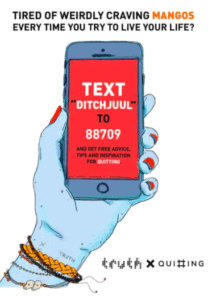Take Down Tobacco National Day of Action
The Take Down Tobacco National Day of Action is a day of activism where communities across the country raise awareness of the dangers of tobacco products and fight to end tobacco use for the next generation.
- Written on: April 1, 2024
- Writen By: Lilliana Riopel
Take Down Tobacco National Day of Action’s purpose is to empower youth and
communities to stand up to Big Tobacco. This time is dedicated to communities to educate their youth about how dependence on tobacco and nicotine impacts an individual’s life in the present and future. Take Down Tobacco encourages parents, teachers, and other community members to get involved with their mission. Getting involved can be as simple as posting on social media to having a large community event going over the effects of tobacco.
How It All Started
Take Down Tobacco’s first campaign event started in 1996 called “Kick Butts Day”. This was a day dedicated to youth to take a stand against the tobacco industry. During this time youth also advocated for policies to reduce youth smoking. As time went on Kick Butts Day program expanded to include training and advocacy opportunities for youth all year round. In 2019, Kick Butts Day was revamped to what we know it is Take Down Tobacco National Day of Action. The purpose of this was to see how much care we have come and how much farther we need to go to achieve the first tobacco-free generation.
How has tobacco use changed?
Tobacco usage in the United States has changed significantly since the 1900s. From 2005 – 2021 cigarette smoking has declined from 20.9% to 11.5%. This means that 12 of every 100 adults are still currently smoking cigarettes. Anti-cigarette advertisements first hit the air in 1967. This intervention was created by the Federal Communications Commission Fairness Doctrine which required broadcast networks
to play anti-smoking advertisements. This ruling stated that broadcasters needed to play one anti-smoking advertisement for every aired cigarette ad. Unfortunately, anti-smoking ads were played once for every four cigarette ads that were played. Due to this, in 1971 cigarette advertisements were officially banned from being aired on television and the radio. This act put an end to the Fairness Doctrine advertisements.
How are we preventing tobacco use?
To prevent and stop tobacco use there have been many different policies and procedures put into place that deter people from smoking. Policies such as increasing the price and taxation on cigarettes to smoke-free places have been shown to decrease the amount people smoke and how many cigarettes people are smoking. Educating youth on the risk factors and outcomes of smoking in various places such as school or community events can help prevent and delay youth using tobacco.
Ways to quit
Quitting Tobacco can be challenging. Many people use tobacco to de-stress and cope with their environment. Having a plan set in place for when stressors or triggers arise is important to continue not to use tobacco. Having little snacks, mints, or gum to help with the need for oral fixation. Oral Fixation is one of the major components of the mental aspect of cigarette addictions. In addition to having a plan in place, it is also important to stay positive and confident in yourself and your ability to stop using tobacco. For more help with quitting, you can go to:
https://www.yesquit.org/curb-cravings.htm
https://quitnownh.org/quit-tips/
References
https://www.takedowntobacco.org/about?section=our-history
https://www.cdc.gov/tobacco/data_statistics/fact_sheets/adult_data/cig_smoking/index.htm
https://www.ncbi.nlm.nih.gov/pmc/articles/PMC3894634/
https://nida.nih.gov/publications/research-reports/tobacco-nicotine-e-cigarettes/how-can-we-prevent-tobacco-use
More Posts You Might be Interested in:
We hope you found this article helpful
For more resources and helpful tips, you can follow our Facebook page at https://www.facebook.com/MonadnockYouthCoalition/.





